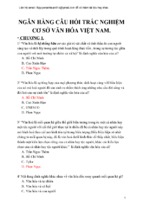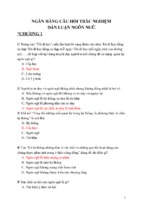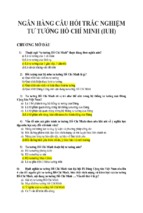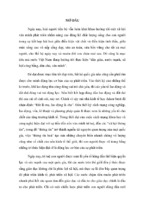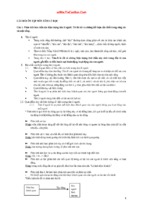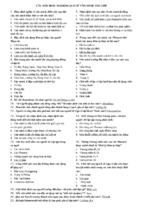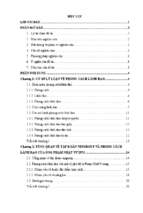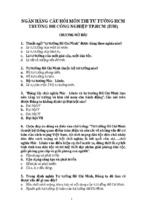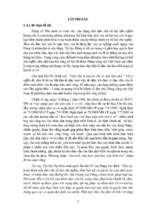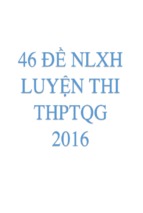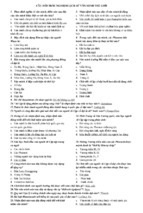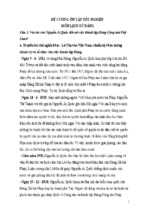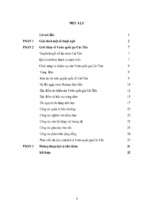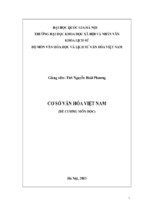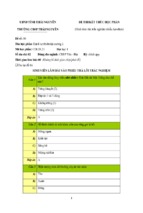MINISTRY OF EDUCATION AND TRAINING
CAN THO UNIVERSITY
SUMMARY OF DOCTOR THESIS
Major: PATHOLOGY AND TREATMENT OF ANIMALS
Major code: 62640102
PhD student: NGO PHU CUONG
STUDY ON CHICKEN GUMBORO DISEASE IN
SOME PROVINCES OF THE MEKONG DELTA
Can Tho, 2019
THESIS WAS COMPLETELY CONDUCTED AT CAN
THO UNIVERSITY
Scientific Supervisor: Assoc. Prof. TRAN NGOC BICH
Thesis was defened with the doctoral thesis examinination
committee of Can Tho University.
Meeting at: ………………………………, Can Tho University
At …. … …. date …. month …. year ….
Opponent 1:
Opponent 2:
Thesis can be found at the library:
1. Learning Resource Center, Can Tho University.
2. National Library of Vietnam.
1
LIST OF PUBLISHED SCIENTIFIC RESEARCH
1. Ngô Phú Cường và Trần Ngọc Bích, 2018. Epidemiological
characteristics of chicken Gumboro disease in the Mekong
Delta. ISSN 1859-2333. Can Tho University Journal of
Science, 54(4B): 40 – 44.
2. Ngo Phu Cuong, Tran Ngoc Bich, and Tran Trung Tin,
2018. Some epidemiological characteristics of Gumboro
disease in household chickens in 5 provinces of the Mekong
Delta. ISSN 1859 – 4581. Science and Technology Journal of
Agriculture and Rural Development, 21(1): 64 – 69.
3. Ngo Phu Cuong, Le Thi Kim Xuyen, Le Thanh Hoa and
Tran Ngoc Bich, 2018. Analysis of characteristic molecular and
pedigree of virulent Gumboro virus strains isolated in 20172018 in Ben Tre and Vinh Long. National Conference on
Biotechnology 2018, 485-490.
4. National Conference on Biotechnology 2018, Ha Noi.
5. Workshop on Science and Technology of Veterinary
Medicine 2018, Hai Duong.
2
Chapter 1: INTRODUCTION
1.1 The importance of thesis
Gumboro disease has been one of the avian diseases causing the
huge economic loss for the poultry industry in many provinces of Vietnam
for a long time. Recently, Gumboro disease shows different mutant strains
belonged to serotype I and II; among them, serotype I has a high virulence
and pathogenicity (OIE, 2008). In Vietnam, Gumboro disease was
officially found from the 1980s based on clinical symptoms, lesions, and
epidemiology. Isolated IBDV with different genotypes and phenotypes
coexist causing the disease progress complicated and difficult for achieving
the effective treatment with vaccination (Nguyen Ba Thanh et al., 2007; Le
Thi Kim Xuyen and Le Thanh Hoa, 2008; Ho Thi Viet Thu, 2012a). The
research of Ho Thi Viet Thu (2012a) indicated that Gumboro disease
usually outbreaks in the flocks without vaccination (70,0%), following by
one-time vaccinated chicken (62,5%) and two-time vaccinated chicken
(28,6%).
In Vietnam, as well as in the Mekong Delta, Gumboro virus is
diverse and complicated because of importing chicken breeds from many
countries on the world. Moreover, IBDV with various genotypes and
phenotypes makes the disease more severe and less effective in treatment
by the vaccine. Therefore, the thesis named “Study on chicken Gumboro
disease in some provinces of the Mekong Delta” was conducted.
1.2 The aim of research
- Determining the prevalence of Gumboro virus in chickens raised
in farms, households in the Mekong Delta. The related factors such as
breeds, ages, vaccinated times, raising methods, death chickens… and some
clinical symptoms in the suspicious infected flocks were included.
- Determining the genetic characteristic of the Gumboro virus
isolated in the Mekong Delta. Comparing the gene encoding VP2 region
with the gene bank, commercial vaccine strains, and creating the genetic
dendrogram of virus in the field.
- Surveying the ratio of immune response and the difference in the
immune response of three Gumboro vaccines in 2 chicken breeds (Ben Tre
3
“Noi” and Luong Phuong)
1.3 The meaning and practice of thesis
Gumboro disease is an acute infectious disease caused by the virus
in the poultry (mainly in chicken and turkey), considering as the classical
disease of the poultry industry. There are many studies on this disease,
virus, and preventive vaccines; however, this disease still outbreaks.
Immunodeficiency significantly affects the preventive efficiency of many
vaccination campaigns in chickens as well as increases the sensitivity of
chickens to other opportunistic pathogens. Some evidence indicated that
IBDV infected chicken flocks could become the host to transmitted other
pathogenic viruses (Pham Hong Son et al., 2012; Ho Thi Viet Thu, 2012a).
Recent reports reveal that IBDV has been one of the important
pathogens causing the enormous economic loss for the poultry industry.
IBDV isolated strains harbor different genotypes and phenotypes to lead
the disease complex and difficult in the effective treatment with the vaccine
(Nguyen Ba Thanh et al., 2007; Le Thi Kim Xuyen and Le Thanh Hoa,
2008; Ho Thi Viet Thu, 2012a).
IBDV’effective prevention contributes to the general health of
chicken flocks and decreases economic loss. Research for vaccine
production based on the sequence of genetic nucleotides from IBDV
isolated in the field has been conducted domestically and internationally.
However, up to now, in the Mekong Delta, the information of decoding the
VP2 region in Gumboro virus was still limited. Therefore, the nucleotide
decryption of Gumboro virus isolated in the field was necessary for
determining the pathogenic level, suitable vaccine selection to prevent
Gumboro disease in chicken flocks, and increasing the economic efficiency
of the poultry industry.
1.4 The new of thesis
By collecting virus strains causing Gumboro disease in the field of
some provinces in the Mekong Delta, comparing the modification of gene
sequence, the antigen and pathogenicity, the resource and genetic
relationship of virus strains, it helps us to select the suitable vaccine strains
to prevent this disease effectively. On the other hand, it contributes to set
4
up a reliable scientific basis for developing the preventive strategy against
the IBD disease in the Mekong Delta and saving the health of chicken
flocks in Vietnam.
Chapter 2: RESEARCH CONTENTS AND METHODS
2.1 Research contents, research time, and research places
2.1.1 Nội dung nghiên cứu
Content 1: Study on the prevalence of chicken Gumboro disease in
the Mekong Delta.
Content 2: Study on the genetic characteristics of Gumboro virus
isolated in the Mekong Delta.
Content 3: Study on the immune response of three Gumboro
vaccines selected from the result of Content 2 towards two chicken breeds
(Ben Tre “Noi” and Luong Phuong).
2.1.2 Research time: from 10/2015 to 10/2018
2.1.3 Research places
Research was carried out in 6 provinces of the Mekong Delta,
including Ben Tre, Hau Giang, An Giang, Can Tho, Vinh Long, Tra Vinh.
About the poultry farming, these provinces have developed both 2 raising
methods: industrial chickens in big farms and household chickens. They are
relatively representative of the poultry production in the Mekong Delta.
For storage and examination of specimens, chicken sera:
Department of Veterinary Medicine, College of Agriculture, Can Tho
University.
For running RT – PCR: Institute of Biotechnology – Vietnam
Academy of Science and Technology, Ha Noi.
For analyzing the sequence of VP2 genes from Gumboro virus in
the field: Macrogen Company, Korea.
For setting the layout of investigated experiments about the
immune response of 3 Gumboro vaccines towards two chicken breeds (Ben
Tre “Noi” and Luong Phuong): Dong Thap province.
2.2 Research facilities
Tools: sample bags, 3 ml syringe, cotton, gloves, distilled tubes,
tube racks, cool box, serum tube, micropipete, falcon tube, scissors, lancet.
Other important facilities: refrigerator, -20oC freezer, -80oC freezer,
vortex, balance, UV-VIS spectrometer, centrifuge, PCR thermocycler,
electrophoresis box, Gel doc.
Direct ELISA kit: IBDV Ag Test (originated from belgium)
delivered from Thoi Dai Xanh company.
Indirect ELISA kit: IBDV Ab Test, Thinh A company.
5
2.2.3 Research object
2.2.3.1 Content 1
- All chickens were raised in Ben Tre, Hau Giang, An Giang, Can
Tho, Vinh Long, Tra Vinh.
- No. of examined chicken flocks: 131 flocks.
2.2.3.2 Content 2
- Fabricius specimens were collect from suspicious chicken flocks
infected with Gumboro disease (Content 1).
- The nucleotides sequence of VP2 genes from Gumboro virus
collected in Ben Tre, Hau Giang, An Giang, Can Tho, Vinh Long,
Tra Vinh.
2.2.3.3 Content 3
Experimental chickens were raised at the households in Dong
Thap. Ben Tre “Noi” chicks at a one-day age were bought from the local
hatchery company. Luong Phuong chicks at a one-day age were bought
from Nong Nghiep Tri Viet L.L.C. Chicks were vaccinated to prevent
Marek disease before supplying for the farmers. Experimental chickens
were fully captive to ensure the hygiene livestock environment, nutrition
source, caring, and vaccination in regular.
2.3 Research method
2.3.1 Content 1
2.3.1.1 Method of the survey on the prevalence of chicken
Gumboro disease in househols/farms
Chicken breeds were mainly surveyed including hybrid “Noi”, Tau
vang, Binh Dinh, Luong Phuong in 3 raising methods: free grazing, halfgrazing, and captivity (Table 2.1).
Table 2.1: The number of examined chicken flocks in the
Mekong Delta
No.
Province
No. of examined flocks
Ben Tre
1
26
2
Hau Giang
15
3
Can Thơ
14
4
Tra Vinh
19
5
Vinh Long
28
6
Total
An Giang
29
131
6
2.3.1.2 Method of the survey on the characteristic symptoms
and lesions in the suspicious infected chicken flocks
Information collection: recording the related information about the
chicken flocks using the questionnaire, when the disease was announced.
Chickens infected Gumboro disease show the symptoms and lesions such
as moodiness, withdrawing their beaks in the wings, falling to one side,
lying down, half-closed eyes, stocking in the corner, picky or skip eating,
drinking much, disorientation, white stools, loose or watery stools with
blood, swollen or hemorrhagic Fabricius bursa, hemorrhagic in chest
2.3.1.3 Method of the Gumboro virus detection
The suspicious infected chicken flocks with Gumboro disease were
examined clinical symptoms and collected feces by using kit IBDV Ag Test
(originated from Belgium) delivered by Thoi Dai Xanh company.
2.3.2 Content 2
2.3.2.1 Method of detection of VP2 gene from Gumboro virus
isolated in the field
- Step 1: Selection of samples
- Step 2: Extraction of ARN from samples
A pair of primer using for RT-PCR: forward GVF: 5’
CAAACGATCGCAGCGATGACAAACCTGCAAGAT 3’ and
reverse GVR: 5’ GGCTTCAAAGACATAATTCGGGCC 3’.
Amplification of gene at “hypervariable region” with molecular
weight: 0.47 kb.
- Step 3: Synthetic of c.DNA from ARN by using Themor kit
- Step 4: Running PCR with c. DNA
- Step 5: Electrophoresis PCR products on agarose gel 2%, at 75V,
50 min to check the amplification of gene.
2.3.2.2 Method of decryption of the nucleotide sequence of VP2
gene and determination of pathogenicity of Gumboro virus
After detection of the VP2 gene from Gumboro virus isolated in the
field, ta total of 10 virus samples, which were good quality, bright DNA
bands, single bands (marked for each province) were selected to analyze
the homogeneous gene. The sequence of VP2 gene was decoded in
Macrogen Company, Korea. The nucleotide sequence of VP2 gene was
compared
by
using
GENDOC2.7
software.
(http://www.nrbsc.org/gfx/gendoc/)
7
2.3.2.3 Method of comparison and creation of the genetic
dendrogram from Gumboro virus isolated in the field with the gene
bank and vaccine strains used in the Mekong Delta
Access on the Gene bank to get the information of Gumboro virus
strains which were announced in Vietnam and on the world, as well as in
the Mekong Delta.
Table 2.2: List of virus Gumboro strains and vaccine strains in
the Gene bank used in this research
Registered Isolated
*Country
Pathogenic
No. Strain code
code
year
group
1
GTN
FJ842498
2003
Vietnam
vv
2
GHUT12
FJ842493
2003
Vietnam
vv
3
GPT
FJ842495
2002
Vietnam
vv
4
GT1ST
DQ355815
2003
Vietnam
vv
5
GTG25
DQ355818
2003
Vietnam
vv
6
GTG
FJ842499
2003
Vietnam
vv
7
HuN11
LM651367
China
vv
8
YS07
FJ695138
2007
China
vv
9
9109
AY462027
2001
USA
av
10 variantE
AF133904
USA
av
11 GLS
AY368653
USA
av
12 IM
AY029166
USA
av
13 STC
D00499
USA
av
14 Cu-1wt
AF362747
Germany
av
15 HN04
KC109816
2011
China
at
16 D78
AF499929
Luxembourg
at
17 HZ2
AF321054
1997
China
at
18 JD1
AF321055
1997
China
at
19 903-78
JQ411012
1978
Hungary
at
20 IBD BLEN
AY332560
USA
av
21 BUR-706
EU544156
Brazil
at
22 Cevac
EU544158
Hungary
at
23 Georgia
KF573194
India
at
24 Nobilis
AJ586966
Netherland
av
vv: very virulent; av: antigenic variant; at: attenuated
8
During the survey, vaccine brandnames were frequently used
including IBD Blen, Bur 706, Ceve Gumboro, Georgia, Nobilis; therefore,
they are applied in this research:
- Vaccine 1: IBD BLEN (MERIAL – USA)
- Vaccine 2: BUR 706 (MERIAL – France)
- Vaccine 3: Cevac Gumboro L (Hungary)
- Vaccine 4: Georgia (India)
- Vaccine 5: Nobilis (MSD – Netherland)
2.3.3 Content 3
2.3.3.1 Method of survey on the immune response of 3
Gumboro vaccines on Ben Tre “Noi” and Luong Phuong chickens
a. Experimental henhouses
The henhouses were the soil-floor with an area of 3.5 m2 prepared
before stocking. The floor was covered with a layer of sand about 20 cm
thick, 15 - 20 cm thick of rice husk on the paddled layer; the roof is made
of nipa leaves. It were fenced with B40 net around, and covered with
canvas to avoid drafts with a feeding light and feeder system for chickens.
Cages, breeding equipment were disinfected before putting chickens into
the experimental henhouses.
b. Experimental arrangment
The experiment were arranged in a completely random block with
4 experiments and 3 replicates (Table 2.3). Each experiment was 30
chickens/tratment. At 3 day-old, chicks were collected the heart blood to
check the maternal antibodies; thus, a total of 60 chicks were used.
Chickens were continuously raised in the experiments to collect the vein
blood of wings. The total of chickens were used: 4 experiment x 2 breeds x
3 replicates = 720 chickens.
Table 2.3: Experimental arrangement
No. of chickens used in the
No. of
experiment (chickens)
Breed
replicates
EX1
EX2
EX3
EX4
Ben Tre “Noi”
3 times
30
30
30
30
Luong Phuong
3 times
30
30
30
30
EX1: the control treatment (without vaccination); EX2: IBD BLEN (MERIAL –
USA); EX3: Cevac Gumboro L (Hungary); EX4: Nobilis (MSD – Netherland)
9
2.3.3.2 Method of collecting blood to examine the anitibodies
Table 2.4: Summary of vaccination times and collecting blood
to examine the antibodies
Experiment (chickens)
Time
Day-old (day)
EX1
EX2
EX3
EX4
Vaccination
First time
7
180
180
180
Second time
28
180
180
180
Blood collection
Before vaccination
3
60
First time
21
60
60
60
60
Second time
42
60
60
60
60
EX1: Control; EX2: Vaccine IBD BLEN; EX3: Vaccine Cevac Gumboro L; EX4:
Vaccine Nobilis
The antibodies were examined by the direct ELISA assay of
Gumboro virus. Indexx ELISA kit (USA) was supplied by Thinh A Com
pany (Ho Chi Minh City).
2.4 Examined indexes
2.4.1 Content 1
- Characteristics of chicken flocks infected Gumboro disease:
breed, raising method, age, vaccinated times...
- The ratio of symptoms and lesions in Gumboro infected chickens.
- The ratio of infected samples.
- The ratio of death chickens due to Gumboro disease.
2.4.2 Content 2
- The sequence of nucleotide and amino acid of isolated Gumboro
virus strains.
- The homogenous level of the sequence of nucleotide and amino
acid of Gumboro virus strains isolated in the filed and IBDV vaccine
strains.
- The homogenous level of the sequence of nucleotide and amino
acid of Gumboro virus strains isolated in the filed and other strains in
Vietnam and on the world (published on the Gene bank).
- The genetic origin of Gumboro virus in the field.
2.4.3 Content 3
- The rate of immune response between 2 chicken breeds, used
vaccine, and vaccination times.
10
- The difference of immune response between 2 chicken breeds,
used vaccine, and vaccination times.
2.5 Data analysis
The experimental data were analyzed by using the Excel software.
The statistics and variance were analyzed by using Minitab 16. The
comparison of the experimental avergaes were examined by Chi-Square
and Tukey method of Minitab 16.
Chapter 3: RESULTS AND DISCUSSIONS
3.1. Content 1: Survey on the prevalence of chicken Gumboro
disease in some provinces of the Mekong Delta
3.1.1. Characteristics of chicken flocks infected Gumboro
disease
3.1.1.1 The ratio of Gumboro infected chicken flocks among
chicken breeds
Table 3.1: The ratio of Gumboro infected chicken flocks among
chicken breeds
Suspicious
Percentage
Breed
Infected flocks
infected flocks
(%)
Hybrid “Noi”
52
15
28,8
Tau Vang
19
13
68,4
Binh Dinh
31
17
54,8
Luong Phuong
29
14
48,3
Total
131
59
45,0
P = 0,012
The suspicious Guboro infected flocks showed the symptoms:
ruffled feathers, moodiness, drinking much, less or skip eating, white-stools
diarrhea, stocking in the corner, increasing temperature before falling
down. The feces were collected to examine the infected flocks by using the
IBDV Ag Test kit (Thoi Dai Xanh Company). The results of Table 3.1
showed that the infected chicken flocks were respective in each chicken
breeds as 15 flocks of hybrid “Noi”, 14 flocks of Luong Phuong, 13 flocks
of Tau Vang, and 17 flocks of Binh Dinh. The total rate of infected chicken
flocks was 45%.
The ratio of infected chickens was significantly different among
chicken breeds (P<0,05); the highest rate was Tau Vang chicken (68,4%),
while the lowest ones was hybrid “Noi” chickens (28,8%). It indicates that
the resistance against Gumboro disease depends on the genetic
characteristic of chicken breeds that affect on the early immune response to
IBDV.
11
3.1.1.2 The ratio of chicken Gumboro disease by raising
methods
Table 3.2: The ratio of chicken Gumboro disease by raising
methods
Method
Free grazing
Half-grazing
Captivity
Total
No. of suspicious
infected flocks
50
60
21
131
No. of infected
flocks
14
33
12
59
Percentage
(%)
28,0
55,0
57,1
45,0
P = 0,009
Table 3.2 showed that there was different significantly in the rate
of Gumboro disease among raising methods; this disease occured primarily
in free grazing or half-grazing chickens (57,1%, 55,0% respectively), and
the lowest rate was in the captive chickens (28,0%) (P<0,05). The reason
might be that the grazing method reduced stress due to the keeping
(concentration, uncertain hygiene, lack of ventilation...); therefore, chickens
were resistant well against the disease in comparison with captive chickens.
3.1.1.3 The ratio of chicken Gumboro disease by ages
Table 3.3: The ratio of chicken Gumboro disease by ages
No. of suspicious
infected flocks
No. of infected
flocks
Percentage
(%)
12 - 21 days old
43
20
46,5
21 - 42 days old
54
31
57,4
> 42 days old
34
8
23,5
Total
131
59
45,0
Age
P = 0,008
The results of Table 3.3 revealed that chickens at 21-42 days old
were infected Gumboro diease at the highest rate (57,4%), following by
chickens at 12 – 21 days old (46,5%), and chickens at over 42 days old
(23,5%). This difference was significant in statistics (P<0,05). Thus,
Gumboro disease mainly occurred in chickens at 21-42 days old
12
3.1.1.4 The ratio of Gumboro disease among vaccinated or
unvaccinated chicken flocks
Table 3.4: The ratio of infected chicken flocks by vaccination
times
Percentage
Vaccinstion times Vaccinated flocks Infected flocks
(%)
Unvaccination
36
24
66,7
01 times
42
22
52,4
02 times
53
13
24,5
Total
131
59
45,0
P=0,001
Table 3.4 showed that unvaccinated flocks were infected this
disease at the highest rate (66,7%), following by one-time vaccinated
chickens (52,4%), and the least ones in two-time vaccinated chickens
(24,5%). This comparison indicated that there was significantly different
between unvaccinated chickens and one-time vaccinated chickens
(P = 0,001).
3.1.2. The frequency of symptoms and lesions in chickens
infected Gumboro disease
Table 3.5: The frequency of the clinical characteristic
symptoms in infected chickens (n=59)
No. of
samples
Frequency
Percentage
(%)
59
59
100
59
59
100
59
56
94,9
Smeared feces on the cloaca
59
46
77,9
Dry skin of shanks
59
45
76,3
Self-pecking on the cloaca
59
21
35,6
Clinical symptoms
Skip eating, ruffled feather,
drinking much
Moodiness, down head, and
swooping wings
Watery white-stools, green
stools
13
Fig 3.1: Clinical symptoms of chickens infected Gumboro disease
(A: wet and smeared feces on the cloaca; B: ruffled feather, down head)
The clinical symptoms included the watery and white/green stools
(94,9%), smeared feces on the cloaca (77,9%), dry skin of shanks (76,3%),
and self-pecking on the cloaca (35,6%). By inspection of 59 chickens that
were representative for 59 infected flocks, the gross lesions were recorded
in Table 3.6.
Table 3.6: The frequency of lesions in Gumboro infected
chickens (n=59)
The frequency
Organ
Lesions
No. of
samples
Percentage
(%)
Fabricius bursa
Swoolen,
haemorrhage, atrophy
59
100,0
Thigh musscle
Haemorrhage
45
76,2
Chest musscle
Haemorrhage
32
54,2
Spleen
Swoolen and/or
necrosis
19
32,2
Kidney
Swoolen
8
13,5
Intestine
Haemorrhage
19
32,2
Between the
proventriculus and
gizzard
Haemorrhage
26
44,1
14
Fig 3.2: The lesions of Gumboro disease in chickens
(A: haemorrhage on thigh, B: Swoolen and pale kidney, C: Swoolen Fabricius
bursa, accumulating external mucus; D: haemorrhage at the between of
proventriculus and gizzard)
3.1.3. The ratio of chicken Gumboro disease in provinces of the
Mekong Delta
Table 3.7: The ratio of Gumboro infected chickens in the
surveyed provinces
Province No. of flocks No. of infected flocks
Percentage (%)
Ben Tre
26
11
42,3
Hau
15
9
60,0
Giang
Can Tho
14
7
50,0
Tra Vinh
19
9
47,4
Vinh
28
12
42,8
Long
An Giang
29
11
37,9
Total
131
59
45,0
P = 0,812
Of 131 chicken flocks, 59 flocks were infected Gumboro disease
with the characteristic symptoms and lesions. Among provinces, chicken
flocks in Hau Giang got the highest infected rate (60,0%), and the lowest
ones was in An Giang (37,9%).
3.1.4 The ratio of death chickens due to Gumboro disease
Table 3.8 exhibited that the death rate of chickens due to Gumboro
disease was not much high (4,81%). However, there was a significant
15
difference among the surveyed provinces (P = 0,001); the highest rate of
death chickens was in An Giang while the lowest ones was Ben Tre.
Table 3.8: The ratio of death chickens due to Gumboro disease
No. of
No. of
No. of
Percentage of
Province
infected
infected
death
death (%)
flocks
chickens
chickens
Ben Tre
26
11.200
365
3,25
Hau Giang
15
4.500
225
5,00
Can Tho
14
3.600
153
4,25
Tra Vinh
19
7.200
450
6,25
Vinh Long
28
9.200
455
4,95
An Giang
29
3.900
259
6,64
Total
131
39.600
1.907
4,81
P = 0,001
3.2. Content 2: Study on the genetic characteristics of Gumboro
virus isolated in the Mekong Delta
PCR assay was carried out to detect VP2 gene from Gumboro virus
strains. The PCR products were obtained at 474 bp; and Fig 3.3 showed the
DNA bands were quality, bright and single.
Fig 3.3: The electrophoresis of PCR products from IBDV strains
M: DNA marker
16
3.2.1 The nucleotide and amino acid sequence of IBDV isolated
strains and vaccine strains
Fig 3.4: A part of the chromatogram of the nucleotide sequence in
the hypervariable segment of VP2 gene
Fig 3.4 showed that the sequence was analyzed, and each color of
the chromatogram presented for one kind of nucleotide. This chromatogram
revealed the excellent quality of the sequence. This nucleotide sequence
was compared with other published sequences on the Gene bank; it showed
relatively homogenous. It means that all steps of RT-PCR (primers,
thermocycling…) were corrected.
Table 3.9: The variable location of nucleotide making the
different amino acids among the examined samples
Location of
M1 M2 M3 M4 M5 M6 M7 M8 M9 M 10
nucleotide
724
A
A
A
A
A
A
A
A
A
A
725
A
A
A
A
G
A
A
A
A
A
726
C
C
C
C
C
C
C
C
C
C
766
C
C
C
C
C
C
G
G
C
C
767
G
G
G
T
C
G
T
T
T
T
881
A
G
G
A
A
A
A
A
A
A
M1: Tra Vinh; M2: Hau Giang 1; M3: Hau Giang 2; M4: An Giang; M5: Can Tho
1; M6: Can Tho 2; M7: Ben Tre 1; M8: Ben Tre 2; M9: Vinh Long 1;
M10: Vinh Long 2
The results indicated that there were 53 variable locations of
nucleotide in comparison to 10 virus strains isolated in this research.
Among these locations, 6 locations (724, 725, 726, 766, 767, 881) made the
chances of amino acids at the critical locations (242, 256, 294) to transform
the pathogenicity of virus samples in the field (Table 3.9).
17
Bable 3.10: Vị trí sai khác Nucleotide dẫn đến sai khác amino
acid giữa các mẫu nghiên cứu và vaccine
Variable
location
M1: Tra Vinh; M2: Hau Giang 1; M3: Hau Giang 2; M4: An Giang; M5: Can Tho
1; M6: Can Tho 2; M7: Ben Tre 1; M8: Ben Tre 2; M9: Vinh Long 1; M10: Vinh
Long 2; VC1: IBD Blen; VC2: Bur 706; VC3: Cevac Gumboro L; VC4: Georgia;
VC5: Nobilis
The analyzed results of the nucleotide sequence were exhibited in
Table 3.10. The samples isolated in the field (M1, M2, M3, M4, M6, M7,
M8, M9, and M10) showed that the locations at 222, 242, 253, 256, 279,
294, 299 and 329 had the amino acid sequence of A-I-Q-I-D-A-I-S-A; it
was not found in any the high pathogenic strains. The M5 sample belonged
to the attenuated group with many varieties at 8 locations (A222P; I242V;
Q253H; I256V; D279N; A284T; I294L; S299N) in comparison with the
high pathogenic strains. The comparison of nucleotide sequences between
vaccine strains and virus strains in the field indicated that there were a total
of 81 different locations; however, the variety at 8 locations (724, 725, 726,
766, 767, 836, 837, and 881) changed the amino acid sequences (242, 256,
279, 294) to transform the pathogenicity. Thus, 3 of 5 important locations
modified the pathogenicity were 242, 256, 294.
Table 3.11: The location of modified amino acid in the epitope of VP2
gene from virus strains in the field and strains in the Gene bank
No.
Strain
High pathogenicty
1
M1
2
M2
3
M3
4
M4
5
M6
6
M7
7
M8
Pathogenicity
vv
vv
vv
vv
vv
vv
vv
The location of transformed amino acid in the epitope
222 242 253 256 279 284 294 299 329
A
I
Q
I
D
A
I
S
A
A
I
Q
I
D
A
I
S
A
A
I
Q
I
D
A
I
S
A
A
I
Q
I
D
A
I
S
A
A
I
Q
I
N
A
I
S
A
A
I
Q
I
D
A
I
S
A
A
I
Q
I
D
A
I
S
A
A
I
Q
I
D
A
I
S
A
18
No.
Strain
Pathogenicity
The location of transformed amino acid in the epitope
222 242 253 256 279 284 294 299 329
A
I
Q
I
D
A
I
S
A
A
I
Q
I
D
A
I
S
A
A
I
Q
I
D
A
I
S
A
A
I
Q
I
D
A
I
S
A
A
I
Q
I
D
A
I
S
A
A
I
Q
I
D
A
I
S
A
A
I
Q
I
D
A
I
S
A
A
I
Q
I
D
A
I
S
A
A
I
Q
I
D
A
I
S
A
A
I
Q
I
D
A
I
S
A
A
I
Q
I
D
A
I
S
A
A
I
Q
I
D
A
I
S
A
A
I
Q
I
D
A
I
S
A
T
V
Q
V
N
A
L
N
A
N
V
Q
V
D
A
L
N
A
N
I
Q
V
D
A
L
N
A
P
I
Q
V
D
A
L
N
A
P
G
Y
L
N
T
L
T
A
S
V
Q
I
N
A
L
N
V
8
M9
vv
9
M10
vv
10
GTG
vv
11
GTG25
vv
12
GTN
vv
13
GT1ST
vv
14
GPT
vv
15
GHUT12
vv
16
YS07
vv
17
9109
vv
18
variantE
vv
19
GLS
vv
20
HuN11
vv
Variant pathogenicity
21
STC
av
22
IM
av
23
Cu-1wt
av
24
VC1
av
25
VC5
av
Attenuated
P
V
H
V
N
T
L
N
pathogenicity
26
M5
at
P
V
N
V
N
T
L
N
27
D78
at
P
V
H
V
N
T
L
N
28
HZ2
at
P
V
H
V
N
T
L
N
29
JD1
at
P
V
H
V
N
T
L
N
30
HN04
at
P
V
H
V
N
T
L
N
31
VC2
at
P
V
H
V
N
T
L
N
32
VC3
at
P
V
H
V
N
T
L
N
33
VC4
at
P
V
H
V
N
T
L
N
M1: Tra Vinh; M2: Hau Giang 1; M3: Hau Giang 2; M4: An Giang; M5: Can Tho
1; M6: Can Tho 2; M7: Ben Tre 1; M8: Ben Tre 2; M9: Vinh Long 1; M10: Vinh
Long 2; VC1: IBD Blen; VC2: Bur 706; VC3: Cevac Gumboro L; VC4: Georgia;
VC5: Nobilis. vv: very virulent; av: antigenic variant; at: attenuated.
IBDV strains isolated in Vinh Long, Tra Vinh, Ben Tre, Can Tho,
Hau Giang, and An Giang were both belonged to the high pathogenicity
group; it showed via the clinical symptoms and lesions. All the samples
were collected from the unvaccinated chicken flocks with Gumboro
disease. The samples collected in Can Tho having M5 strains were
attenuated strains (Table 3.11) with unclear clinical symptoms and lesions.
19
R
A
A
A
A
A
A
A
A
- Xem thêm -

